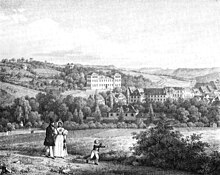Carl Friedrich Heinzmann
Carl Friedrich Heinzmann (born December 2, 1795 in Stuttgart ; † July 9, 1846 ) was a German landscape and porcelain painter and lithographer .
life and work
Carl Friedrich Heinzmann was taught by the court painter Johann Baptist Seele and began his military service as a volunteer in 1814. Although he was promoted to officer in France, he left his military career to go to Munich for further training in 1815, supported by the king. Here he studied landscape painting, especially under Wilhelm von Kobell . His versatile talent soon found such recognition that he got a job at the royal porcelain factory as early as 1822 . He mostly painted cheerful and peaceful nature scenes, which he gave a unique style through perfect and careful execution.
He particularly enjoyed spending his time in the Bavarian, Swiss and Tyrolean Alps, which gave him material for a series of highly esteemed pictures. In addition to his own compositions, he made many copies of famous paintings in the Pinakothek on plates, plates and vases . His main works included a magnificent vase adorned with images of all branches of the Bavarian Army, a gift from Crown Prince Maximilian to the Sultan, as well as a plaque with the various views of Munich and the Munich area, which was presented to King Otto on his departure for Greece.
In 1843 he went to Italy. However, he was unable to artistically process the abundance of sketches made there, as he succumbed to severe pneumonia on July 9, 1846.
Appreciation
Several landscapes can be mentioned among his oil paintings, often with military staffage. In 1823 he made a lithograph of a Cossack ride and lithographed many sheets from his own template (Swiss and Tyrolean regions) or from other masters. The latter include e.g. B. "the Palikaren" after Peter von Hess ; “Withdrawal from Russia” according to Albrecht Adam ; "The chapel on the Rothenberg " after Johann Friedrich Steinkopf (for the Württembergischer Kunstverein ); "View of the Glyptothek", based on Leo von Klenze . For the large atlas on Atanazy Raczyński's History of Modern Art (1840) he lithographed the “Entry of Emperor Ludwig into Munich” (after Bernhard von Neher ), the “View of the Walhalla” (after Leo von Klenze) and the “Criminal from losers Honor ”(after Wilhelm von Kaulbach ). He also made some etchings, e.g. B. "Country people from the Bavarian mountains"; a “Tyrolean farmer drawn from life in Eschenlohe 1827” and a “Christmas market scene” (1843).
literature
- Georg Kaspar Nagler : New general artist lexicon, Vol. 6, 1838, p. 68.
- Atanazy Raczyński : History of Modern Art Vol. 2, 1840, p. 457.
- Vincent Müller: Handbook for Munich , 1845, p. 137.
- Report by the Munich Art Association for 1846 , p. 58.
- Seubert: Künstlerlexicon Vol. 2, 1879, p. 194.
- Hyacinth Holland : Heinzmann, Karl Friedrich . In: Allgemeine Deutsche Biographie (ADB). Volume 11, Duncker & Humblot, Leipzig 1880, p. 664 f.
| personal data | |
|---|---|
| SURNAME | Heinzmann, Carl Friedrich |
| ALTERNATIVE NAMES | Heinzmann, Karl Friedrich |
| BRIEF DESCRIPTION | German landscape painter, porcelain painter and lithographer |
| DATE OF BIRTH | December 2, 1795 |
| PLACE OF BIRTH | Stuttgart |
| DATE OF DEATH | July 9, 1846 |

